A Day at Malim Jetty: How Migrants Work on Goa's Fishing Trawlers
'Pulling the net filled with catch requires lots of strength'
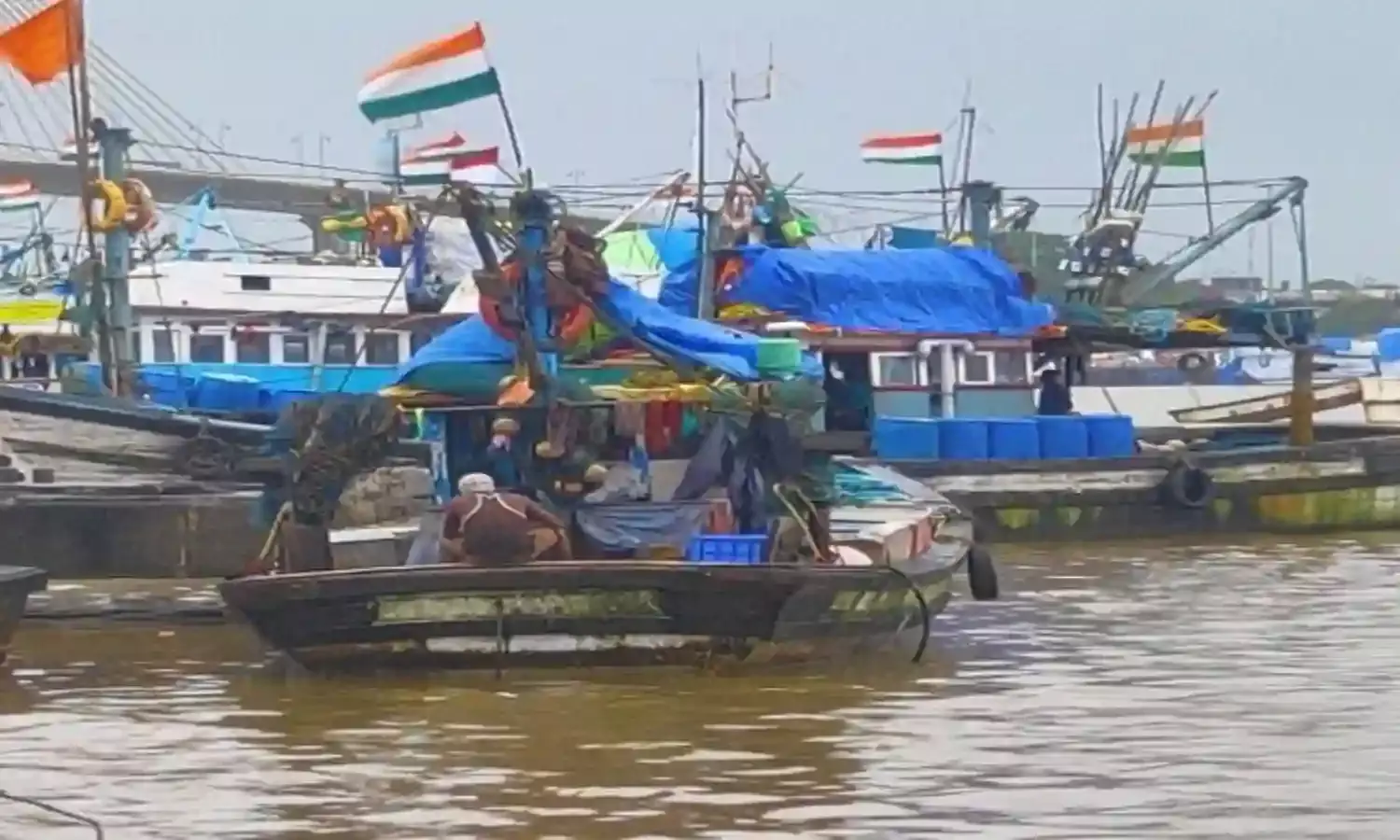
35 year old Bensan Marki first came to Goa at the age of 20, from a village in the Palamu district in Jharkhand. He joined ten fellow villagers returning to their workplace in Goa after a two month break.
“It took us more than 50 hours to reach Goa after leaving our homes,” he says. He came directly to the Malim jetty from Madgaon station as the men he was travelling with were employed at trawlers here.
Like for most workers, social networks are a prominent way of finding work at these trawlers. Samuel (42), John (38) and Sashi (28) also came to Goa with their fellow villagers. Caste matters too. Before leaving their homes, all of them knew that they could start working at any trawler, unlike their fellow villagers.
Boat managers are another source for the supply of workers at the dock. Jack Marki, 35, shares how “I was given the responsibility of returning with 10-15 new workers from various villages in Jharkhand every year when I used to go on two months vacation.”
Most boat managers were initially workers on these trawlers. Marki explains that because they were very active and communicative, the boat owners gave them management responsibilities.
These include ensuring the supply of ice and diesel in the trawler before it leaves the dock, providing groceries for workers at regular intervals, monitoring the workers’ tasks after they return with the catch, and recording the number of containers of each variety of fish before the catch is loaded in an air-conditioned van.
33 year old Roshan Soren came to Goa from Jharkhand for the first time when he was 21. His eyes fill with tears as he shares the reason that forced him to migrate.
“I was a hockey player. The Danapur Army Hockey team selection was happening, but my coach replaced my form with someone else’s form. I felt very disheartened. I cried for many days. I realized I could not get selected again.
“I packed my bag and came to Goa. A few of my friends were working in hotels here. They wanted me to start working with them, but I did not want to work in hotels. I worked as a security guard for a few months - it was very boring to sit idle.
“By using Google Maps, I got to know about various places in Goa. I also got to know about the fishery and various jetties. With the help of the map I reached Malim Jetty and found work here. It is almost nine years now that I have been working here.”
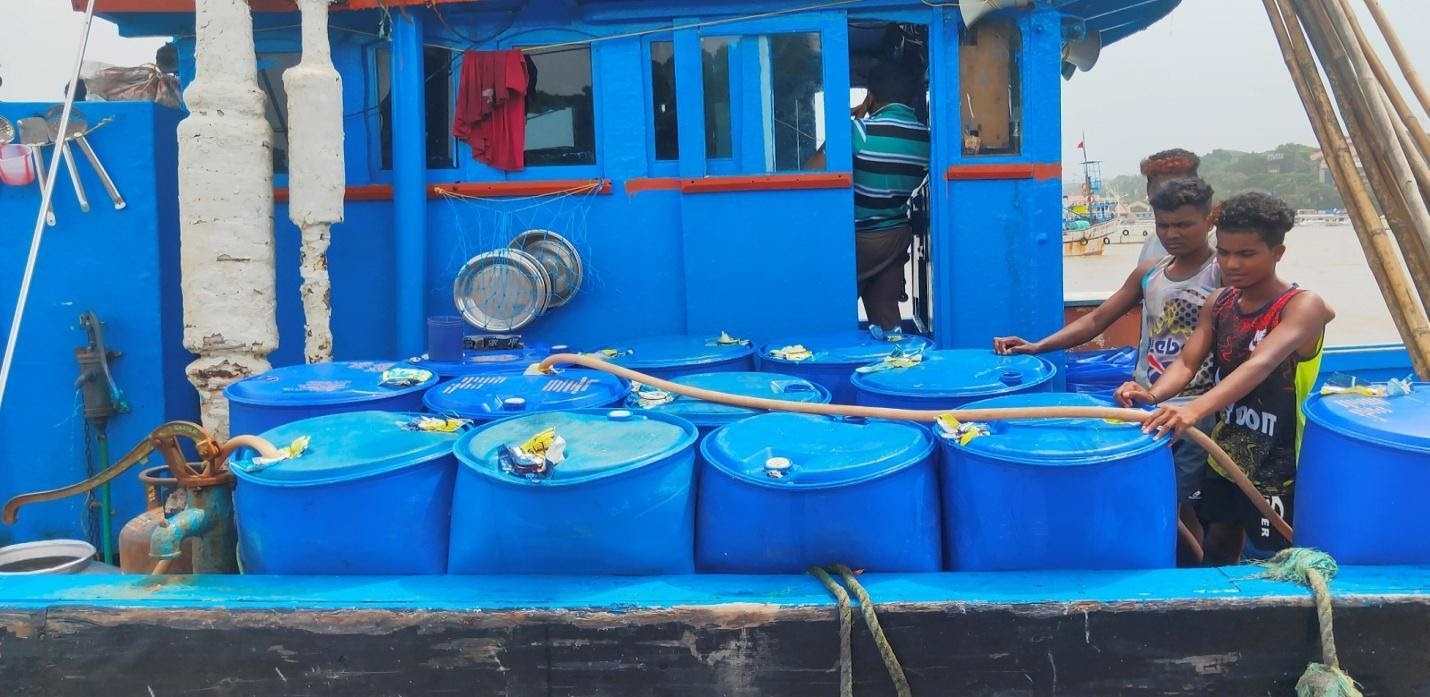
Workers busy with daily chores while the boat is moored at the dock
The trawlers at Malim jetty also become homes for the workers here. They live on the trawler whether it is sailing or moored at the dock. The three sizes of trawlers at the jetty can accommodate about 35, 12 and 8 workers respectively. Only the bigger trawlers contain small cabin-like structures. On the others the workers make do with tarpaulins and sheets.
The living condition of these workers is unimaginable after seeing the cabins. However the workers seem content and shared, “We enjoy it here more than in our native place.”
They get place to relax and walk around on the days their trawlers are parked at the dock. The fishing net, which becomes a six foot wide platform, is used for sitting, conversations and rest.
During our visit more than a hundred trawlers were parked at the dock. We got to know that the boat drivers were from neighbouring Karnataka, visiting their homes on the occasion of Ganpati Puja. Meanwhile the workers still in the trawlers were busy cleaning their clothes, taking a bath, filling water in containers, cooking and eating.
Fish curry and rice have become their regular meal. 36 year old Jacky from Chhattisgarh shared, “Sea fish has become part of our lives. We need at least a piece of it in our meal. We have started loving it so much that we miss it after we are home for two months. No one likes sea fish there.”
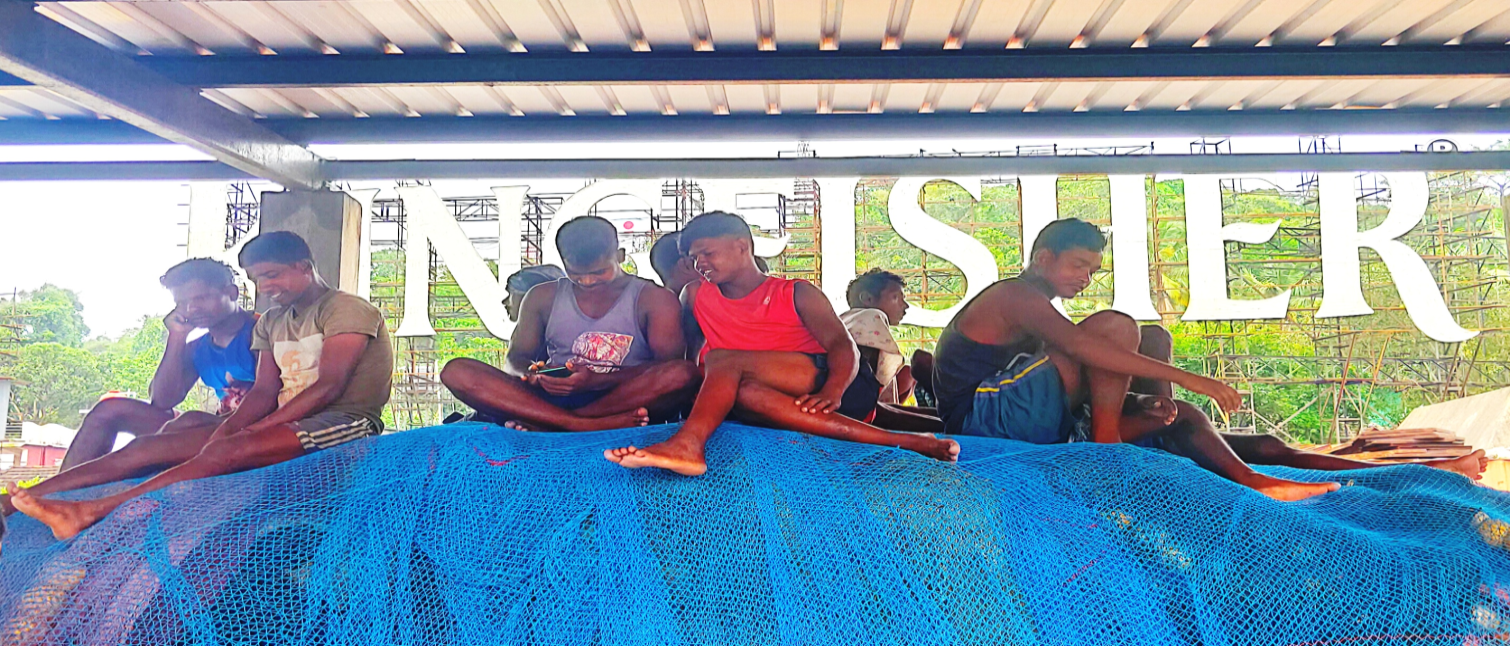
Workers relaxing on a platform made by folding their fishnet
The fishing sector provides regular employment to its workers for ten months. Most continue working with the same owner year after year. On the trawler, one worker has the job of cooking for everyone, while they all clean their own utensils. Groups of workers are responsible also for filling fresh water in large containers, loading the nets, fetching groceries, crushing the ice and filling it in an in-built box before starting the trip.
All workers together spread the net to catch fish and pull it in once the catch has been realised. According to Roshan Soren, the nets used for fishing are so big that they cover more than 15-20 km of sea behind the boat.
“Pulling the net filled with catch requires lots of strength. If there is a good catch, it takes more than ten hours to pull the net, and sometimes it also takes 24 hours,” he explains.
After returning to the dock, the workers unload the fish from the trawler, sort and segregate it in different containers, and load these containers into air-conditioned vans.
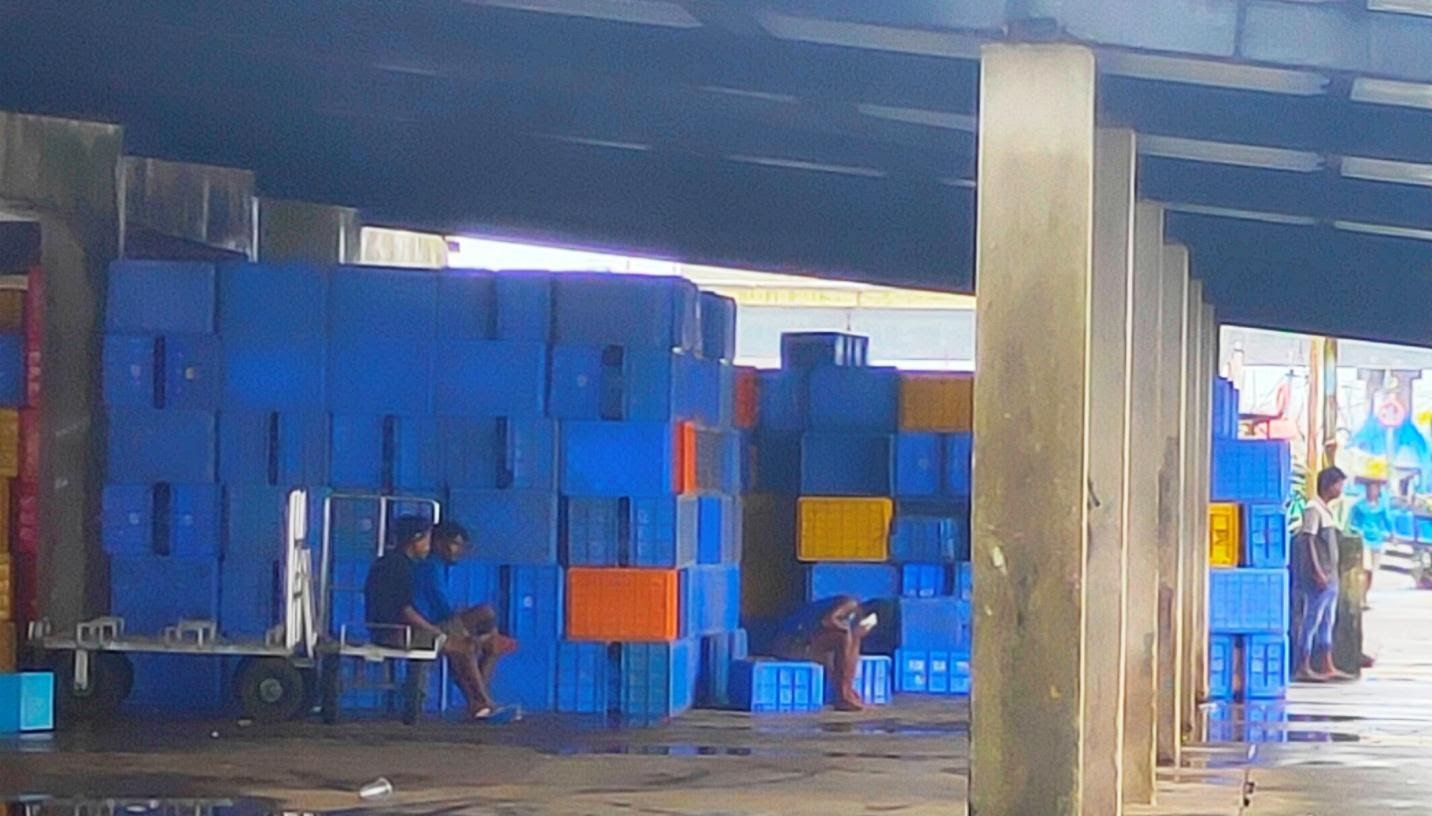
Containers used for sorting and segregating the fish
Once the trawler leaves the dock, the bigger ones usually complete their trip in 15 days, able to go further out to sea, while the medium-sized boats return in 8-9 days and the smaller ones in 5 or 6. It sometimes happens that the driver plans a return before the stipulated time, like when the boat starts running out of ice after enough fish has been caught.
This hardly happens now because of the increase in the number of trawlers, says the chairperson of the Mandovi Fishermen Marketing Cooperative Society, Francis D’Souza. “Sometimes boats have to return without enough catch.”
At sea the fish workers are up against very adverse conditions. They work in extreme heat and humidity, and because of agroindustrial global warming, they face a growing threat of sea storms.
The smell and the turmoil in the sea can make workers feel nauseous even after working in a boat for many years. Of his first sailing experience, 30 year old Subodh shares:
“It was the first time I sat in a boat. Within a few hours the land was not visible. I could see only water and the sky, both of the same colour. I was scared. I started feeling nauseous. One of my villagers gave me a tablet, but I could not resist vomiting. Soon I was empty.”
As Subodh recalls his first experience on a trawler, other labourers agree. They also complain about facing chronic issues like headaches, fever and body pain. Every boat driver is given essential tablets for the crew while they are out at sea.
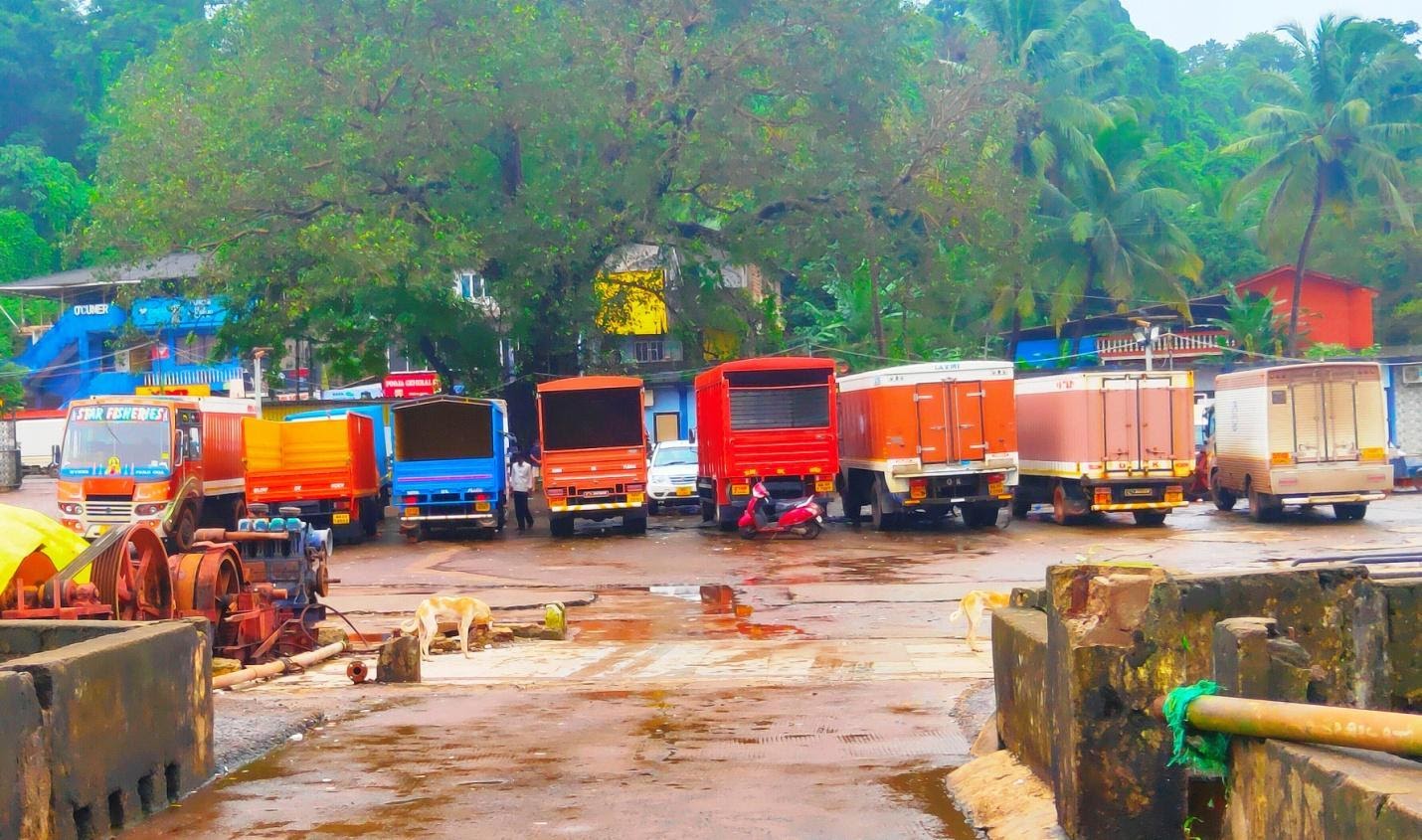
The vans in which containers are loaded
These workers’ monthly income comes to 10,000 to 15,000 rupees. The exact wage depends on the length of their association with the boat owners.
A survey conducted by the Disha Foundation at Malim Jetty found that most of these migrant workers do not have bank accounts. They collect their due wage from the boat owners before returning home, or ask them to transfer the money to a banking correspondent’s account in their villages, who then hands over the money to their family after deducting a service charge.
The survey found that workers feel safer sending money through banking correspondents than carrying it with them while going home. Some of them have fallen prey to money-snatchers while commuting in the past.
The workers at Malim jetty report worsening conditions since 2020. According to the Handbook on Fisheries Statistics 2018 produced by the Union Ministry of Fisheries, Animal Husbandry, and Dairying, the fishery sector is a significant employer in India, providing livelihood to more than 16 million people.
The handbook claims that the fishing industry saw steady growth in production of over 6% per year in the five years to 2018. The report also pegged the sector’s contribution to gross value added that year at Rs 1.78 lakh crore. The industry also is a significant export earner: in 2018 India exported over 1.3 million tonnes of fish worth Rs 45,106 crore.
Before the lockdown was imposed last year, according to Francis D’Souza, more than 5,000 migrant workers from Chhattisgarh, Jharkhand and Odissa were working on approximately 350 trawlers at Malim jetty. But they have still not returned in full capacity since being forced to return home last year.
Most boat owners could not pay their workers during the lockdown and could not finance their return to work. The boat owners have also not recovered from the loss till now. The increase in diesel prices has broken the backs of boat owners, with owners of 4-5 boats now forced to do business with two trawlers only.
The catch is also diminishing. D’Souza explains that he spent 3 lakh rupees on the last trip his trawler made, lasting fifteen days, but netted a catch worth only 70,000.
“If my earning is going to be so less, then I might also park my bigger trawler at the dock and send my middle or the smaller trawler for fishing,” he explains. “This worsening condition of the fishing industry would directly impact the livelihood of migrant workers, who mainly belong to below-poverty-line families”.
Dr Nisha Bharti is guest faculty member at the Centre for Labour Studies, Tata Institute of Social Sciences, Mumbai, and programme manager at the Disha Foundation


